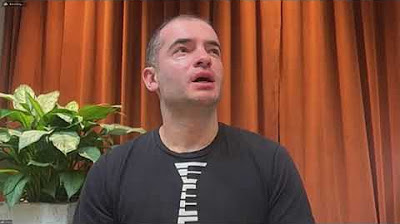Inside OpenAI [Entire Talk]
Summary
TLDR本次访谈中,OpenAI联合创始人兼首席科学家Ilya Sutskever讨论了人工智能的发展,特别是大型语言模型GPT-3的创新及其对社会的影响。Ilya分享了他对AI未来的看法,包括对深度学习、专业训练与通用训练的见解,以及OpenAI从非营利组织转变为有限利润公司的背后逻辑。他还谈到了AI的伦理问题,以及如何平衡技术进步与全球公民责任。Ilya鼓励对AI和创业感兴趣的学生,要信任直觉并利用自己独特的才能和视角。
Takeaways
- 🌟 伊利亚·苏茨凯弗是OpenAI的联合创始人兼首席科学家,对大型语言模型GPT-3及其前身产品ChatGPT的发展做出了重要贡献。
- 🎓 伊利亚出生于俄罗斯,成长于以色列,并在多伦多大学完成了数学学士和计算机科学硕士及博士学位。
- 🧠 伊利亚认为,人工智能的发展受到人类大脑神经元工作原理的启发,人工神经网络通过学习数据来提高预测能力。
- 📈 伊利亚讨论了人工智能的潜力,包括在特定领域如法律或医学中通过专业数据集训练来提高性能。
- 🚀 伊利亚提到,尽管目前人工智能在学习和适应方面与人类存在差异,但未来可能会达到或超越人类的学习速度。
- 🌐 OpenAI的使命是确保人工智能的发展惠及全人类,公司从非营利组织转变为有上限利润的公司,并与微软建立了合作关系。
- 💡 伊利亚强调,随着人工智能能力的增长,未来可能会出于安全考虑而不再开源这些模型。
- 📊 伊利亚认为,衡量OpenAI成功的关键是技术进步、研究执行情况以及对模型的控制和引导。
- 🔍 伊利亚提到,尽管OpenAI的某些方面是封闭的,但公司仍为学术研究提供了不同形式的模型访问权限。
- 🎭 伊利亚个人非常喜欢GPT-3的诗歌创作能力,他认为这是人工智能一个有趣且引人注目的特点。
- 🤖 伊利亚讨论了人工智能在团队中的集成如何提高生产力,尽管目前尚未对团队动态产生显著影响。
- 🌍 伊利亚表达了对全球人工智能监管和合理进步的看法,认为未来可能会有更多的政府监管来确保人工智能的安全和负责任的使用。
Q & A
Ilya的背景和教育经历是怎样的?
-Ilya出生于俄罗斯,五岁时移居以色列,在以色列度过了他的成长岁月。他在以色列完成了大学前半部分的学习,之后转学到多伦多大学,获得了数学学士学位。之后,他在多伦多大学继续深造,获得了计算机科学的硕士和博士学位。
Ilya在OpenAI的角色是什么?
-Ilya是OpenAI的联合创始人和首席科学家,致力于构建对全人类有益的人工通用智能。
Ilya对于大型语言模型的看法是什么?
-Ilya认为大型语言模型是一种强大的技术,通过训练大型神经网络来预测文本中的下一个词,从而实现对人类语言的深入理解和生成。
Ilya如何看待人工智能的未来,特别是在学习速度和适应性方面?
-Ilya认为虽然目前人工智能在学习和适应方面与人类有很大不同,但他不会押注反对人工智能在未来某个时刻达到或超过人类的学习速度和适应性。
Ilya对于意识或自我意识的看法是什么?
-Ilya对意识问题持开放态度,他认为意识可能是一个程度问题,并且对于未来的人工智能系统,如果它们能够展现出与人类类似的意识特征,那将是非常值得思考的。
OpenAI的使命和转变是怎样的?
-OpenAI的使命是确保人工通用智能的利益普惠全人类。它最初是一个非营利和开源组织,后来转变为有限责任公司,并与微软建立了紧密的合作关系。
Ilya如何看待OpenAI的开源与闭源的转变?
-Ilya认为在人工智能的能力较低时,开源是有益的,但随着能力的提升,出于安全考虑,闭源可能变得必要。OpenAI的闭源决定是出于对人工智能能力增长的预期和对安全性的考虑。
Ilya对于OpenAI的盈利模式有何看法?
-Ilya解释说OpenAI是一个有利润上限的公司,这意味着一旦对投资者的义务得到履行,OpenAI将再次成为一个非营利组织。他认为这种结构是独特的,并且有助于平衡公司的使命和经济需求。
Ilya对于人工智能在全球范围内的监管和伦理问题有何看法?
-Ilya认为未来的世界需要明智的政府监管来确保人工智能的发展是可控和负责任的。同时,他也认为每个国家都有其在全球人工智能发展中的角色和责任。
Ilya对于想要进入AI领域的斯坦福学生有什么建议?
-Ilya建议学生们应该发挥自己的独特优势和直觉,深入研究自己感兴趣的领域。他认为在研究和创业方面,独特的视角和创新思维都是非常重要的。
Ilya如何看待深度学习在未来5到10年的发展?
-Ilya预计深度学习将继续取得进步,尽管通过扩大模型规模来获得进步的时代可能已经结束,但深度学习在许多层面上仍有改进的空间,这些改进将共同推动领域的发展。
Outlines

This section is available to paid users only. Please upgrade to access this part.
Upgrade NowMindmap

This section is available to paid users only. Please upgrade to access this part.
Upgrade NowKeywords

This section is available to paid users only. Please upgrade to access this part.
Upgrade NowHighlights

This section is available to paid users only. Please upgrade to access this part.
Upgrade NowTranscripts

This section is available to paid users only. Please upgrade to access this part.
Upgrade NowBrowse More Related Video

Ilya Sutskever: Deep Learning | Lex Fridman Podcast #94

Interview with Dr. Ilya Sutskever, co-founder of OPEN AI - at the Open University studios - English

Ilya Sutskever (OpenAI Chief Scientist) - Building AGI, Alignment, Spies, Microsoft, & Enlightenment

Ilya Sutskever | AI neurons work just like human neurons | AGI will be conscious like humans

Shane Legg (DeepMind Founder) - 2028 AGI, Superhuman Alignment, New Architectures

GPT-4o:8 種應用解說、最適合大眾的免費 AI?即時對話、語言學習、學科解題家教|OpenAI 發佈會|雷蒙三十
5.0 / 5 (0 votes)
